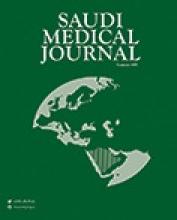Abstract
OBJECTIVE: To evaluate the roles of surface electrocardiogram ECG and transthoracic echocardiography ECHO for prediction of atrial fibrillation AF after coronary artery bypass grafting CABG.
METHODS: This study was conducted from 2002-2004 at the Cardiovascular Department of Hacettepe University, Ankara, Turkey. Seventy consecutive patients were enrolled in this study that underwent elective CABG. A 12-lead ECG was recorded one day before cardiac surgery and was repeated during the 5 days after CABG. P-wave dispersion PWD was defined as the difference between maximum and minimum P-wave duration. Differences in P-wave duration were compared between the pre- and postoperative 12-lead ECG measurements.
RESULTS: Postoperative AF developed in 17 24% cases of 70 patients. The PWD was found to be significantly higher in patients with AF preoperatively 60±19 versus 47±13, p=0.003, postoperative first day 56±12 versus 44±11, p<0.002 and fifth day 51±29 versus 41±11, p<0.001. Patients with AF were significantly older, the mean age of the AF group was 68±7 years and of the sinus rhythm SR group was 59±10 years p<0.001. The AF group had left ventricular systolic dysfunction 56±13% versus 56±8%, p=0.042, preoperatively; 49±8% versus 60±10%, p=0.001, postoperatively and a larger left atrium 46±5 versus 39±5 mm, p<0.001, preoperatively and 44±7 versus 39±5 mm, p=0.046, postoperatively than the SR group.
CONCLUSION: This prospective study demonstrated that PWD on surface ECG and additional echocardiographic parameters are simple and reliable indexes to predict the development of AF after CABG.
- Copyright: © Saudi Medical Journal
This is an open-access article distributed under the terms of the Creative Commons Attribution-Noncommercial-Share Alike 3.0 Unported, which permits unrestricted use, distribution, and reproduction in any medium, provided the original work is properly cited.






